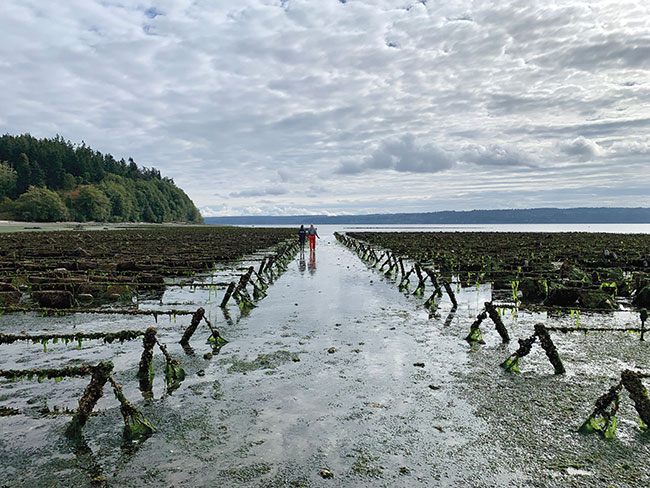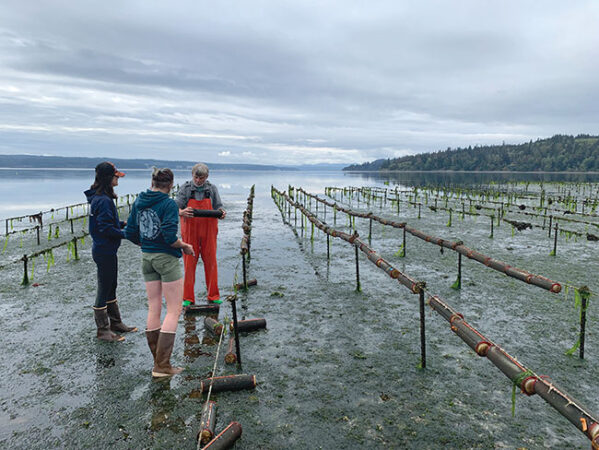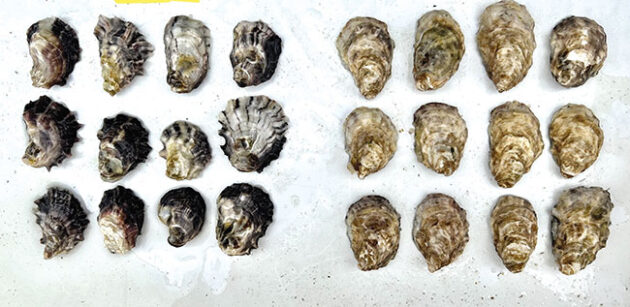
High hopes for hybrid
March 1, 2023
By
Mari-Len De Guzman
Proprietary crossbreeding program tackles challenges in shellfish aquaculture
 Photos: Pacific Hybreed, Inc.
Photos: Pacific Hybreed, Inc. Crossbreeding Pacific oysters to improve resilience and produce higher yield could be a game-changer for shellfish aquaculture, and proponents of Manchester, Wash.-based Pacific Hybreed are getting ready to test drive their innovative breeding program at farms in a variety of environments across North America.
Co-founded by scientists Joth Davis and Dennis Hedgecock, both international experts in shellfish biology and genetics, Pacific Hybreed has developed what it claims is the first-of-its-kind shellfish breeding program creating genetic lines of superstar oysters that can withstand a changing climate, survive diseases, and significantly improve a farm’s production yield.
The company’s cutting-edge crossbreeding platform is the offshoot of decades of research conducted by Davis and Hedgecock while working as scientists at Taylor Shellfish, also in Washington state.
“(Pacific Hybreed) was based on research that we published that just described the use of crossbreeding as a means to improve the yield and other characteristics of oysters.
“We took the opportunity to develop a private breeding company to see if we could utilize the approaches that we learned to basically create a way of improving yield and other characteristics in both oysters and other shellfish,” said Davis, cofounder and chair of the board at Pacific Hybreed.
Pacific Hybreed’s research hatchery is located within the National Oceanic and Atmospheric Administration’s Northwest Fisheries Science Center Research Station in Manchester, Washington. The company also has a production and genetics facility in Kona, Hawaii, which is where the actual genetic lines will be produced, according to Davis.
Pacific oyster presents a great opportunity for Pacific Hybreed to serve a climate-challenged shellfish aquaculture sector facing increasing ocean acidification and diseases that threaten crop survival.
“The opportunities with just Pacific oysters are enormous. It’s the most-farmed oyster across the planet,” said Davis. But the technique can also be applied to other shellfish such as Eastern oysters and Manila clams, which are next on the company’s crossbreeding agenda.
This summer, the company is planning to test its hybrid stock at different farms to see how they hold up in different environments.
“We’ve been operating since about 2019… to develop the genetic lines that we will be using in what are referred to as test crosses and see how the environment and the genetics of the Pacific oyster lines interact to create, hopefully, (genetic) combinations that do very well,” Davis explained.
The strategy, he adds, is to establish a good number of genetically distinct families composed of pair-mated lines which will be tested to see how they perform in different combinations of temperature and salinity and other environmental factors.

Photos: Pacific Hybreed, Inc.
Plant-based
Traditional shellfish aquaculture uses selective breeding to enhance production. Pacific Hybreed’s approach uses crossbreeding, taking a page from traditional plant breeding techniques. In plants, crossbreeding involves botanically mixing two plant species to create a hybrid that takes only all the best traits of the parent plants.
“What we found is that the genetics of some agricultural crops, such as corn and rice, and oysters, actually, behave fairly similarly. No one else is using crossbreeding the way we are for crop improvement in oysters and other shellfish,” Davis said.
With crossbreeding, he explained, every line is genetically distinct with all the different traits – such as shell characteristics, the depth, cup and color of the oyster – they can all be highlighted with individual pair-mating among oyster lines.
“So down the road, we could also, for example, focus on designer oysters… So, if a grower or hatchery really likes the color of the shell, or the deep cup, or whatever it might be, there’s going to be a catalog, essentially, of the different phenotypes that are available to the grower or to the hatchery. We’re just really getting into the opportunities associated with crossbreeding that are different than what you find in a pure selection program,” said Davis.
Francis Pan, Pacific Hybreed’s director of genetics and breeding, says field testing is a key component of the program.
“We take a base population, a wild population, so there is abundant genetic variation in our population. And we create pair-mated families, where each is quite unique in their genetic background. We field test those genetic lines, propagate them and find the elite lines for crossbreeding between families… So, in that case, we can always go back to the same families and do the same mating again,” Pan explained.
The company’s success will be measured by how well its hybrid broodstock performs on a commercial farm and its bottom line.
“We actually deploy our families under the environmental condition that commercial production will take place. So, we’ll be looking at survival (rate) and growth on farms for selected lines,” Pan said.
Field testing is also a big part of the business model the company is proposing, according to Davis, which provides farms an opportunity to test Pacific’s crossbred hybrids without necessarily incurring the cost upfront.
Participating farms will be given Pacific Hybreed seeds to grow at their farm, alongside a generic oyster seed, serving as the control group. If the Pacific Hybrid stock produces better yield than the control seed, the company will take a percentage of the revenue from that gain, Davis explains.
“One of our jobs is to develop these collaborations (with growers), as we get the available seed to test with different growers to establish these test spots that, very importantly, have control lines that are generic oyster seed embedded so that we can quantify the difference between our seed and that generic oyster seed. That would be our fundamental value proposition,” Davis said.
Baywater Shellfish, a shellfish farm that Davis founded with his wife Karen in 1990, will be one of the first companies field-testing Pacific’s broodstock.

Field test site, Bay Water Shellfish.
Climate resilience
Climate change and rising ocean temperatures have wreaked havoc on shellfish farming. Pacific Hybreed wants to create a new breed of shellfish that can thrive in changing water conditions and survive diseases.
With global population expected to reach 10 billion by 2050, global food security is an increasing concern. If aquaculture is to produce the protein the world will need, it will require cutting edge innovation in farming technology. Through its crossbreeding program, Pacific Hybreed aims to help create a stable and sustainable supply of high-performing shellfish for the aquaculture market.
Testing their seeds in different environmental conditions will allow Pacific Hybrid to develop climate-resilient genetic lines. So, the company plans to conduct test crosses in a variety of ocean conditions.
“Our plan is to put out test crosses in places as diverse as Alaska, Southern California and perhaps Mexico. So that covers the range of places where Pacific oysters are cultivated for aquaculture,” Davis explained.
“That allows us to focus on the traits that do well under different geographic conditions… We’re seeing heat waves or increasing local coastal acidification, or we’re seeing changes in rainfall patterns that impact salinity number, or for that matter, disease outbreaks… We will learn, in theory, which lines do better than others, and will obviously focus on the lines that do better. And so that allows us then to develop the broodstock for hatcheries and growers to use for the production of oyster seed for their operations.”
Next steps
Pacific Hybreed is currently in talks with farms to field test its seeds. Davis says it’s still a long road ahead for the company before it fully realizes its goals.

Two different oyster families produced by controlled, pair-mating using different female and male brood oysters. Families were reared under the same hatchery conditions and show distinct shell-colour patterns. Individuals having darker-color shells belong to one family, and the animals with lighter-colour shells came from another family.
“One of the biggest challenges we have is that it takes time to develop the different generations necessary. The way it works is we establish what we call a G zero line, which is basically taking a wild male and a wild female from nature and crossing that together to make a family and then that family line grows up. And then to develop the inbred lines, we take a brother and a sister from each of the founder lines and cross those to make a partially inbred line. And then those are then put out and grown right to reach (reproductive) maturity… and then the unrelated inbred lines are then crossed to create an intraspecific hybrid line. And those lines are what are tested in the different environments.
“And so, we’ve been working on developing the G zero lines, the founder lines and inbred lines. And we’re really focused now on this first generation of hybrid lines,” Davis explained. He expects this first generation will be ready by early summer.
Funding is another challenge. As the company continues to operate its breeding program and run a hatchery, raising capital is an on-going undertaking. The company has attracted some lucrative investments in the past, though, including an $800,000 investment from Builders Vision and Pacific6 last year.
Davis may be a scientist by heart but running a business is not new to him, having started Baywater Shellfish in 1990. And with Pacific Hybreed, he gets to wear both hats.
“I get to focus on science, to some extent, and business to some extent, as needed. So that’s more or less my role these days, which is fine with me. We’re young, we’re developing, we’re pre-revenue, but we’re having a fun time doing it.”





